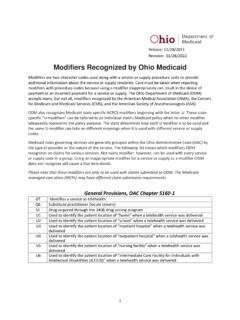Transcription of Exercise Based Therapy for the Treatment of Dysphagia
1 Exercise Based Therapy for the Treatment of Dysphagia MICHELLE THOMAS CCC-SLP. Dysphagia : The Basics Dysphagia , or difficulty with swallowing, is a medical disorder that impacts as many as 15 million Americans, with approximately one million people annually receiving a new diagnosis of the condition.(ASHA 1994). According to the Agency for Health Care Policy and Research (AHCPR), over 60,000 Americans die from complications associated with swallowing dysfunctions each year, most commonly aspiration pneumonia caused by food or saliva going down the windpipe and into the lungs. Dysphagia : The Basics A large proportion of these cases are due to Dysphagia arising from a variety of causes, primarily stroke, degenerative neurological diseases, and head and neck cancer.
2 One in 17 people will develop some form of Dysphagia in their lifetime, including 50 to 75 percent of stroke patients and 60 to 70. percent of patients who undergo radiation Therapy for head and neck cancer. Estimates of Dysphagia 's prevalence in such neurological diseases as Parkinson's Disease and ALS run as high as 90 percent. (AHRQ 1999). Basic Swallow Anatomy and Physiology Normal vs. Disordered Normal Disordered Normal vs. Disordered Swallow Normal Swallow Disordered Swallow tents/pt1/fig_ tents/pt1/fig_ Goals of Dysphagia Therapy 1. Maintain a safe swallow or reduce the risk for penetration/aspiration (decrease risk of infection).
3 Intake Traditional methods do all of the following, however the swallow is not normal. Which may result in repetition of abnormal swallow patterns. Current Dysphagia Therapy Techniques 1. Evaluate with use of instrumental swallow testing: Typically Modified Barium Swallow Study (MBSS) or FEES. 2. Determine area of weakness/deficits 3. Treatment Based on results: Much of today's current treatments center around strength alone with little evidence Based research documenting the benefits of therapeutic exercises in alleviation of swallow disorders Practicioners now looking towards established principles of Exercise to see if they will translate to swallowing rehabilitation (Clark, 2005).
4 Common/Current Dysphagia Therapy Techniques 1. Compensation Short term adjustments Posture Example: seated out of bed at 90 degrees chin tuck, head turn Common Therapy Techniques 2. Diet and liquid consistency changes Example: Level 2 diet with nectar liquids Common Swallow Exercises Used in Therapy Effortful Super-Supraglottic Masako Mendelsohn Shaker's HARD / EFFORTFUL SWALLOW. PURPOSE. To increase tongue base retraction and pressure during the pharyngeal phase of the swallow and reduce the amount of food residue in the valleculae of the throat. APPLICABILITY. Patients who exhibit residue in the valleculae after the swallow.
5 SUPPLIES. ___ Only saliva swallow ___ Food/Liquid swallow INSTRUCTIONS. Swallow normally but squeeze very hard with your tongue and throat muscles throughout the swallow. Excess effort should be clearly visible in your neck during the swallow. Perform with each food/liquid swallow. Perform ___ times throughout the day. SUPER-SUPRAGLOTTIC SWALLOWING MANEUVER. PURPOSE. To close the airway at the vocal fold level before and during swallow, to increase tongue base retraction and pressure generation, and to clear residue after the swallow. APPLICABILITY. Patients who exhibit penetration into the airway with aspiration after the swallow.
6 Patients who can follow multistep directions. ___ Only saliva swallow ___ Food/Liquid swallow INSTRUCTIONS. 1. Hold your breath very tightly, bearing down (lightly cover your tracheostomy tube, if present). 2. Continue to hold your breath tightly while swallowing. Swallow hard. 3. Clear your throat/cough immediately after swallowing. 4. Swallow again. ___Perform with each food/liquid swallow. Perform ___ times throughout the day. WARNING. Patients with uncontrolled high blood pressure should not use this maneuver; bearing down may raise blood pressure. Talk with your Doctor before beginning any Exercise regimen.
7 TONGUE HOLD Exercise (Masako). PURPOSE. To increase the tongue base and throat muscles range of motion. APPLICABILITY: Patients who exhibit reduced tongue base/pharyngeal wall movement. SUPPLIES. ___ Only saliva swallow ___ Liquid swallow between repetitions INSTRUCTIONS. 1. Protrude your tongue slightly from your mouth. Keeping your mouth moist is helpful for this Exercise . 2. Hold the tongue gently with your teeth. 3. Swallow while keeping your tongue protruded. Perform ___ times throughout the day. Common/Current Dysphagia Techniques Criticism for historical approaches to Dysphagia Therapy Strong bias towards presumption of weakness and strength training only.
8 Use of exercises that do not replicate desired task. Examples: Shaker's Exercise or tongue protrusion exercises Criticism Use of motor repetition vs. motor learning: motor activity alone is not thought to result in functional recovery especially when impaired motor performance is baseline (Huckabee & Macrae, 2014). Practicing impaired swallowing through intake of safely tolerated food may facilitate pulmonary safety, but have no real therapeutic benefits (Huckabee & Macrae,2014). Is There A Better Solution? Rehabilitation: Rebuild Function Current studies show that some Dysphagia programs Based on the principles of Exercise physiology can result in: 1.
9 Safe/functional swallow pattern leading to a decrease in infection 2. Increased oral intake 3. Increased efficiency Without the use of unnatural postures and compensatory strategies moving towards normal.. Underlying Goal: Muscle Retraining Muscle retraining requires conditioning motor patterns Endurance and Resistance needed Endurance builds slow muscle fibers Resistance builds fast muscle fibers Traditionally, SLPs attempt to target endurance and resistance through swallow exercises Examples: Masako, Mendelsohn, Effortful However, not often a tailored systematic approach and exercises result in abnormal swallow pattern.
10 Exercise Principles and Dysphagia Therapy New Programs aim to use the following principles of Exercise for Dysphagia Therapy for reorganization of muscles 1. Frequency: sets/reps- at this time ill defined for swallow Therapy : must rely on principles arising from studies of health limb musculature. (Clark, 2005). 2. Intensity: intensity must increase over time: progression protocols: still waiting for specific studies related to intensity for traditional swallow Based exercises. (Clark, 2005). Principles continued 3. Feedback and Specificity: regarding task performance: We know that improved performance is heavily influenced by the presence of guidance and feedback (Salomi, Schmidt, & Walter, 1984).







